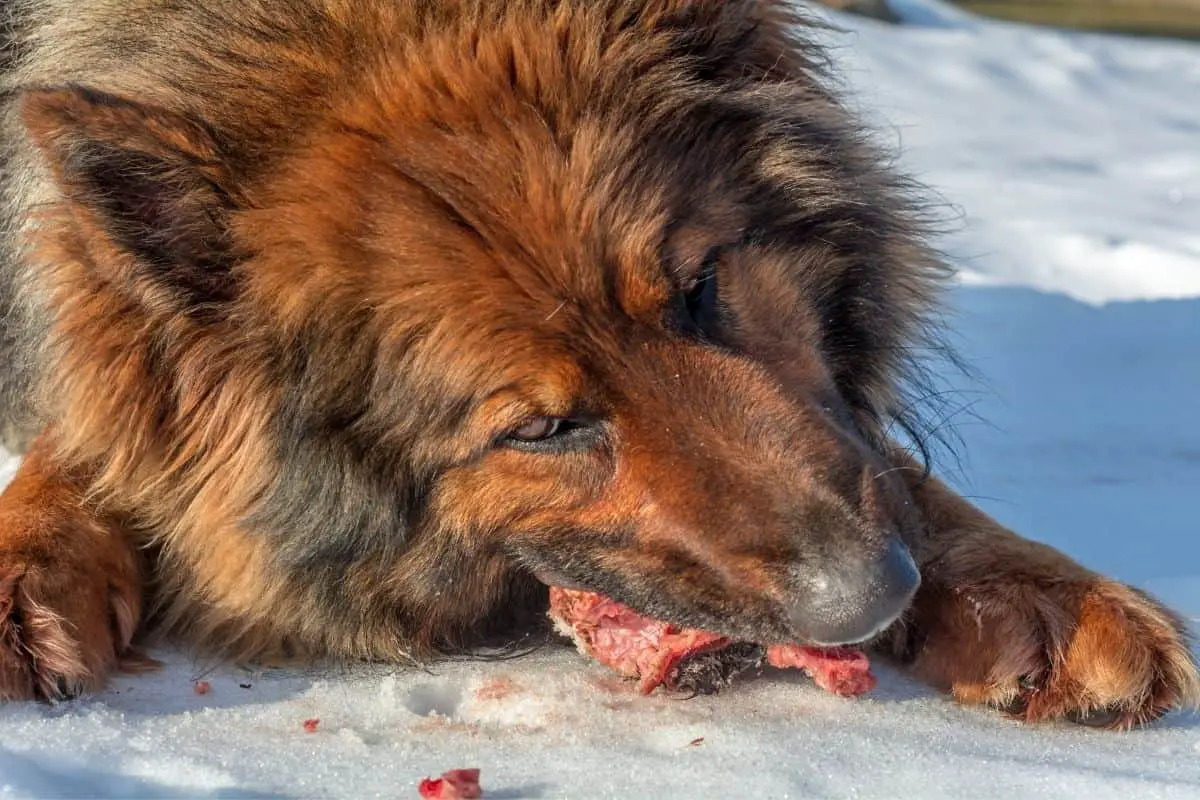This post contains affiliate links.
You can find many raw delicacies worldwide, such as sashimi in Japan, steak tartare in France, or sago worm in Borneo. Undercooked food or raw fish or meat that’s not prepared correctly can certainly make you very sick from food poisoning caused by bacteria from E-coli to salmonella, even parasitic worms. If you have a pet dog, you might wonder if it’s okay to give raw meat to your dog.
You and your dog can eat raw meat as long as it’s properly prepared. However, feeding your dog with raw meat that hasn’t been adequately frozen isn’t very safe. Uncooked meat can transmit parasites like the Taenia solium (pork tapeworms) or Echinococcus granulosus (dog tapeworms) to your dog.
Keep reading to learn more about what you and your dog need to know about raw meat and how feeding raw meat can expose both you and your dog to worms.
Table of Contents
Raw Meat and Parasites
According to CDC, about 48 million people get sick every year, 128,000 are hospitalized, and 3,000 die from a foodborne illness. Most of the infections are caused by bacteria, viruses, and parasites. Parasites like Taenia saginata (beef tapeworm), Taenia Solium (pork tapeworm), and Taenia Asiatica (Asian tapeworm) can infect people and animals and make them sick when they eat raw or undercooked meat.
You might wonder, how did parasites like the tapeworm get to the meat in the first place? Your answer lies in the life cycle of the tapeworms. We’ll discuss it now.
The Life Cycle of the Tapeworm
Tapeworms need a living host to thrive, and these parasitic creatures reproduce quickly, and they’re everywhere — your body included. Often, people don’t realize that they have tapeworms growing inside of them. An infected person may experience abdominal pain, weight loss, and anus irritation.
Below is the life cycle of the tapeworm:
- The eggs or gravid proglottids are passed with feces. Usually, the eggs can survive in the environment for days, even months. The eggs are usually on the grass, somewhere accessible by animals.
- A cattle or a pig gets infected by eating vegetation contaminated with eggs or gravid proglottids. The oncospheres, which are the larval forms of the tapeworm, will hatch in the animal’s intestine.
- The oncospheres penetrate the animal’s intestinal wall and move to the striated muscles. The oncospheres will develop into cysticerci. A cysticercus can live in the animal for several years before humans consume them via raw or undercooked infected meat.
- Once ingested by a human host, the cysticercus will develop into an adult tapeworm in over two months. The tapeworm can survive in its host for years. In order to thrive, the adult tapeworm attaches itself to the host’s small intensive by their scolex.
- The tapeworm continues living in the host’s small intestine. Eventually, the adult tapeworm will produce proglottids which will mature and turn into gravid. The gravid then detaches from the tapeworm and migrates to the host’s anus or goes into the human stool, about 6 per day.
- The stool will end up in the water or grass, and the cycle repeats once again.
An adult tapeworm, such as the T. saginata, can grow up to 25 m, whereas the T.solium can grow up to 7 m. In China, a 20-foot-long tapeworm was found in a man who enjoyed eating raw beef. The worm had lived in his body for at least two years.
Tapeworms in Dogs
Dogs can get infected by tapeworms as well, and they can become very sick from them. Feeding raw meat to your dogs can expose them to parasites. It would be best to cook the meat before feeding it to your dogs because not only correctly cooked meat is easier for your dog to digest, it is also safe from parasites.
Here’s how a tapeworm can infect your dog:
- The dog swallows a host of tapeworm eggs, usually an adult flea, typically when grooming themselves or grooming other canine housemates. A dog might also get infected when it scavenges animals like rodents or birds infected by the eggs.
- The tapeworm eggs will stay in the dog’s small intestine.
- The tapeworm eggs will develop into adult tapeworms and can grow up to 28 inches in length. Its body is made up of many small segments, known as proglottids. A tapeworm can live in a host for up to 30 years.
- The tapeworm’s segments will break off once the tapeworm has matured inside the dog’s gut. The broken segments will make their way to the dog’s stool, ending in the environment again. The cycle begins once again with a brand new host.
Eating Infected Raw Meat
You or your dog can get sick from eating raw meat that is not prepared correctly. Uncooked meat can cause food poisoning and parasite transmission to the body. A dog infected by tapeworm will become weak and tired.
Other symptoms include:
- Weight loss, despite eating normally
- Nausea
- Vomiting
- Dull coat
You may also see the tapeworms in your dog’s vomit. It’s best to be careful once you notice that your dog is infected with parasites like the Dipylidum because you don’t want to get infected, too. Although the risk of you getting infected with a dog’s tapeworm is very low, you still need to watch out, especially if you have children around.
How To Protect You and Your Dog From Worm Infection
The best way to prevent you and your dog from getting infected is by eating properly cooked meat only. It is safe to give your dog canned dog food as it is cooked meat only. If you want to prepare the meat at home, make sure you cook it properly.
You want to avoid feeding raw meat to your dog to prevent you and your family member from getting exposed to the bacteria and develop a foodborne sickness. You can infect your dog with bacteria and parasites when you handle the raw meat, let your dog lick your hands, clean up dog feces, or touch contaminated surfaces. It would be best not to give your furry friend an animal stomach or intestines, which are animal parts where parasites are commonly found.
As mentioned earlier, dogs can get infected with parasites when they accidentally ingest infected fleas. You should apply a flea preventive to your dog. All dogs should also be given deworming medications, as prescribed by the veterinarian.
It would help if you always cleaned up after your pet, especially after taking it out for walks. If you notice your dog feeling itchy on the butt, this could be an indication that your dog has tapeworms. As soon as you see this, it would be best to take your dog to the veterinarian.
Final Thoughts
You and your dog can get food poisoning or exposed to parasitic worms like tapeworm when consuming raw or undercooked meat. To protect yourself and your canine from getting infected by parasites, you should eat only cooked food. Canned dog food is always cooked, so you may want to give it to your dog.
Parasites like tapeworm (also transferable via fleas) can make your dog ill when ingested. When infected, your dog may experience weight loss, lethargy, vomiting, or nausea. If you notice parasitic worms have infected your dog, send it to the vet right away.
Sources
- Healthline: 8 Gross Parasites and Bacteria That Could Be Hiding in Your Food
- CDC: Parasites – Taeniasis
- Live Science: Man Gets 20-Foot Tapeworm from Eating Raw Meat
- Raw Paws Pet Food: Can Raw Feeding Give Pet Worms and Parasites?
- WebMD: What You Should Know About Tapeworms
- CDC: Dipylidium FAQs
- AKC: Tapeworms in Dogs: Symptoms, Treatment, and Prevention
Mrdogfood.com is a participant in the Amazon Services LLC Associates Program, an affiliate advertising program designed to provide a means for sites to earn advertising fees by advertising and linking to Amazon.com. We also participate in other affiliate programs which compensate us for referring traffic.





